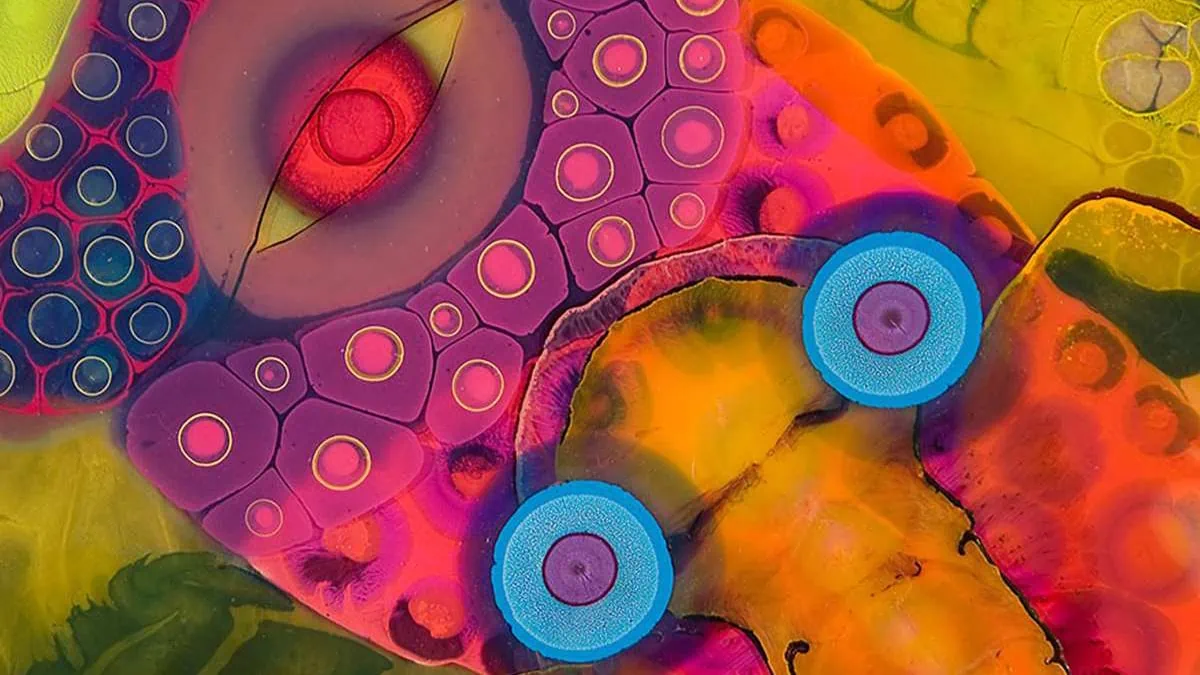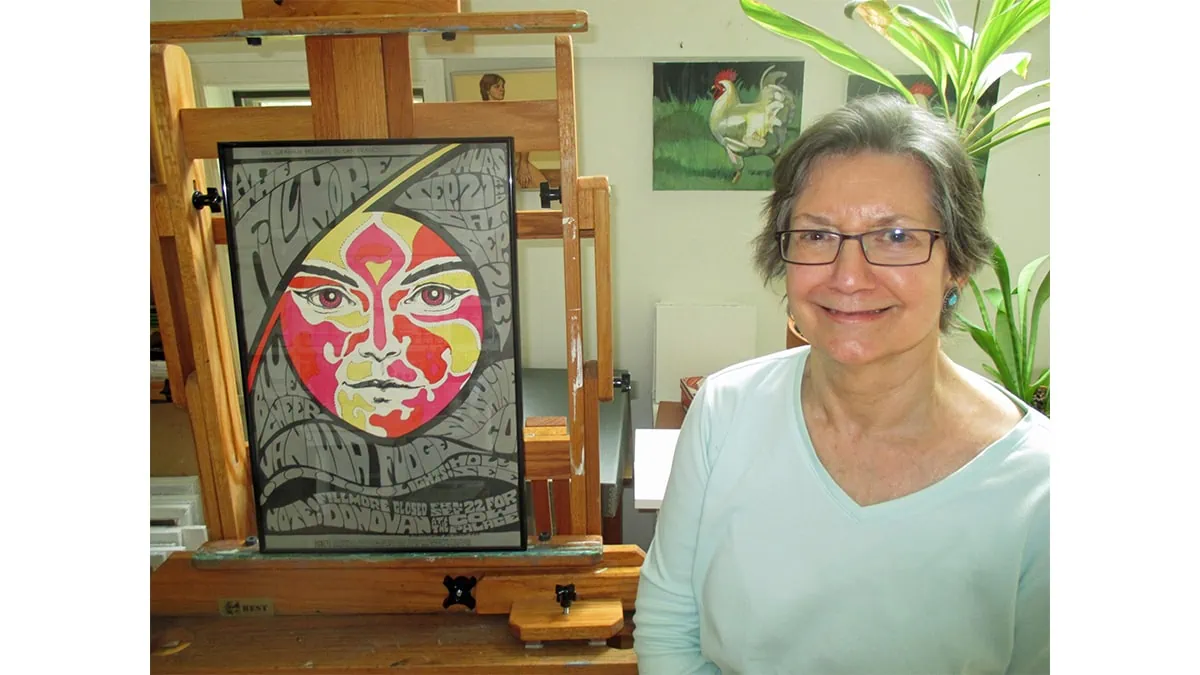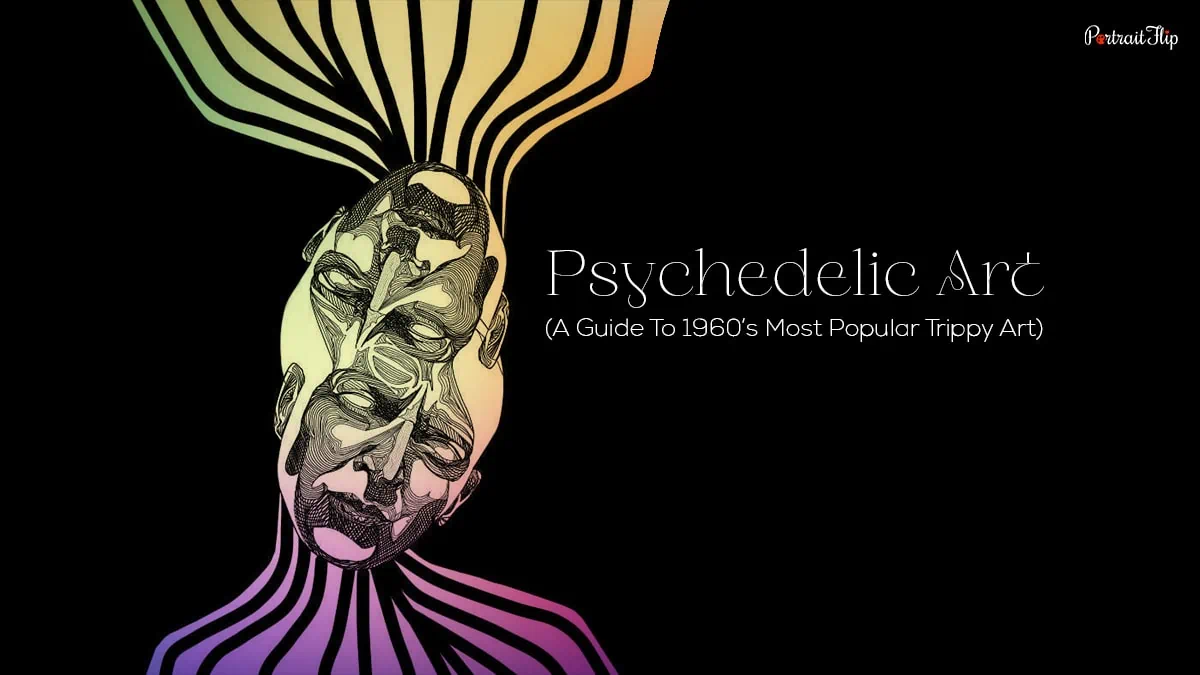If you look at any psychedelic artwork, you’ll see a composition full of bright, contrasting colors and distorted images—something that’s messy, unorganized, and chaotic!
But why on earth would anybody make such a type of art?
The answer lies in its vast and mysterious history, which made the psychedelic art movement come into existence and later flourish across America in the 1960s.
If I have to explain to you what psychedelic art is, I’d say: It’s a type of trippy art that reflects the sensations and experiences caused by psychedelics—LSD, iboga, ayahuasca, peyote, and mushrooms.
Artists would ingest drugs and bring visuals—appearing in their minds—onto the canvas.
But why?
Wasn’t there any other alternative to producing art? Was it legal to take drugs and make art in the 1960s?
Countless questions come to mind when we hear psychedelic art.
Therefore, PortraitFlip decides to present a blog answering all the questions related to the existence of psychedelics and its art movement.
Table of contents
What is Psychedelic Art?
Psychedelic art is a visual representation of our mind when intoxicated with LCD or psilocybin.
Here’s a compilation image of psychedelic art.
Art appears as if colors are splashed, spilled, and spread across the canvas.
There’s repetition in art to some extent. Patterns are being shown, making the art kaleidoscopic.
The psychedelic art movement that emerged in the 1960s had its roots in Art Nouveau, which we’re going to talk about in detail in the next section.
But did you know that if Dr. Humphry Osmond and Albert Hofmann hadn’t collaborated, we would certainly never have witnessed this most liberating art movement of all time?
What did these people do? Were they the only people who led the development of the psychedelic art movement?
The Background of Psychedelic Art

It was Dr. Osmond who took a few steps ahead that resulted in the development of the psychedelic art movement in the 1960s.
But since we’re talking about the history of psychedelic art, we must go back to the 1950s and learn some important events from Albert Hofmann’s life, a Swiss chemist who discovered LSD by isolating compounds found in ergot.
In 1938, Hofman was on the verge of discovering something unusual, but his work was being disrupted several times, and it lasted for the next five years.
In 1943, he returned to his earlier therapeutic work and accidentally absorbed a negligible amount of drug, which produced a dreamlike hallucination.
It was a trippy experience, which persuaded him to ingest more of it, which he did several times.
He had never experienced something like this before.
A mescaline experience that later became a phenomenon—carried by hippies in the 1960s
After discovering the hallucinatory effects of LSD, he spent the next couple of years investigating its properties.
He did it under the belief that it would help schizophrenic patients; if you look at the history of schizophrenia art, you’ll see the great importance of drugs like LSD.
But something unexpected came out of it, and that’s how this world witnessed the iconic psychedelic art style.
But wait, what was Dr. Humpry’s contribution to it?
Let’s find out.
Dr. Humphry Osmund, Albert Hofmann, and LSD

Albert, after discovering the hallucinatory effects, continued experimenting with psychedelics, which soon caught many researcher’s attention, one of whom was Dr. Osmund.
Dr. Humpry Osmund decided to move to Saskatchewan in 1951, where many researchers were part of a project related to health care reforms.
Tommy Doughlas, being the head of this program, recruited many researchers, including Dr. Humpry Osmund, and through him, Osmund met Albert Hofmann and later collaborated on several projects.
The objective of collaboration was to take the existing research work to another level, which they did in the coming years.
Studying extensively the effects and characteristics of psychedelics, they produced several medical papers and provided insights into the human psyche and behavior after the consumption of psychedelic drugs.
Their ideas would provide help; leading from the front, both made several health reforms that positively brought changes to those who suffered from alcoholism and other drug abuse.
Development of Psychedelic Art
The news of their work spread like wildfire, which pivoted the attention of poets and artists.
These new minds explored psychedelics; they even learned how dramatic the effect could be.
After knowing the nitty-gritty of LSD and other drugs, they, without giving much thought, introduced psychedelic art to their communities.
Several reasons enticed them, one of which was that it was meant to challenge the traditional art approach, which most artists were tired of.
Gaing love, admiration, and encouragement across different regions resulted in the formation of a new art form called trippy art.
Art made using psychedelics would defy the traditional approach, letting aspiring and experienced artists do whatever they wanted.
They’d ingest drugs and capture the visuals onto a canvas that was dominated by contrasting colors and distorted images.
Psychedelic art, which was gaining momentum in the 1960s, predominantly targeted youth, as most hippies were welcoming to unconventional practices.
(Suggested: 8 Neoclassical Paintings)
The Relationship Between Art Nouveau and Psychedelic Art

As I’ve mentioned, psychedelic art was influenced by the Art Nouveau movement.
Image Title: Art Nouveau and Psychedelic Art
A late-19th-century art movement that mainly condemned the changes caused by the industrial revolution.
Some were glad of what the industrial revolution did to their lives, but a majority of people, especially artists, weren’t happy with the changes.
In order to restrict and condemn it, art was being made in an intricate fashion.
The world of art labeled Art Nouveau as the predecessor of psychedelic art. Both served the same purpose but chose different routes.
Art Nouveau saw hundreds of grand, flowing lines, intricate patterns, vibrant female figures, and exotic themes, which were also seen in abundance in the psychedelic era.
Though psychedelic wasn’t mainstream until artists began borrowing elements from other styles, and that’s how psychedelic drawings and patterns were being made, this was how it became mainstream trippy art.
Intensely contrasted colors became an integral part of psychedelic artworks and were purposely used as they could vibrate any viewer’s eye, giving a clear reference to the LSD trip.
Primarily, doing drugs was a way to get high and get away from reality.
But in the 1960s, the era was different because the artists would consume them in order to demonstrate the visuals—caused by intoxication—through art.
However, psychedelic designs lacked aesthetic value, according to some critics, who, by every means, tried to put the supporters of psychedelics down.
Despite the harsh criticism, individuals kept their focus on its progress and produced hundreds of psychedelic paintings.
As we already know, artists took elements from Art Nouveau, but because of the use of optics and illusion principles, psychedelic art garnered a high percentage of fame and love.
That made it look more vibrating and moving.
As we all know, the essence of Art Nouveau was sprinkled on psychedelic art over and over.
But there was another art style that also had a great influence on the art of psychedelics, the Pop Art Movement; therefore, both were considered predecessors of psychedelic art.
As time went on, it gained momentum in other areas, including comic books, corporate advertising, and popular culture.
However, paintings and posters saw dramatic shifts due to the effects of psychedelics.
Between the 1960s and 1970s, many psychedelic works of art were created, which consisted of vivid contrasting colors, multi-colored swirls, and flamboyant lettering.
Out of all, five pieces of psychedelic art caught many people’s attention, which we will talk about in the next section.
But let’s briefly learn the characteristics of psychedelic art.
Characteristics of Psychedelic Art
You could easily learn what characteristics psychedelic art possesses; let me address them in bullet points.
- Fundamentally associated with Art Nouveau and Pop Art
- Kaleidoscopic in nature
- Surreal, abstract, and morphed subject matter
- Bright and highly contrasting colors
- Symbolic, identical, yet diverse in nature
- Repetition of motifs
- Positive and negative spaces hold almost equal importance
Famous Psychedelic Artists
From music to theater to advertising to painting, psychedelic art cemented its position in different areas of art.
Here are some of those talented psychedelic artists whose works would take you nowhere but back in time and show you the visual representation of hippies.
1. Tokio Aoyama

Tokio, a modern-day talent, produced several renowned psychedelic artworks, keeping vibrancy and surrealism in mind.
His imaginative work made him a respected figure among the various art communities. At several events, he mentioned surrealist artist Salvador Dalí as his muse.
His art is vibrant yet mysterious to some extent, which wouldn’t alter one’s views but would take one on a spiritual trip.
2. Victor Moscoso

Victor was a well-known psychedelic poster artist who would collect elements from comics and commercials to produce art.
He was adept at bringing about hallucinations on the canvas. Probably the first few people to make use of multiple photographic collages to produce innovative styles.
Whoever was part of psychedelic knew the role of colors, but Victor’s knowledge about colors was something beyond one’s limitations.
He gave us the most iconic pieces of psychedelic art, i.e., Big Brother and the Holding Company (1967) and The Chambers Brothers (1967).
3. Wes Wilson

Without a doubt, Wes Wilson was the most influential and talented designer of the psychedelic era.
He was one of the very few people who witnessed the peak of psychedelic art and who, by every means, contributed to its progress
His signature style entails eye-catching images, loud colors, and captivating patterns.
Well known American artist, Wilson, left an impactful legacy behind, which made him a recognized poster artist from the psychedelic era.
4. Peter Max

Peter Max, best known for rainbow-hued prints and posters, cemented its name in almost every art form of psychedelic.
Most of his art is even recognized and circulated on social media. Taking this fact into consideration, you can evidently see how successful he was as a psychedelic artist.
He was a specialist in using popping colors. His exemplary works include Psychedelic Man (1971), 100 Clintons (1993), and Motion (1983).
5. Bonnie MacLean

Hats off to Bonnie, who built her name in a male-dominated community.
Bonnie, being remarkable at her work, was recognized as one of the few females making big during psychedelic time.
Her artwork was as bold and vibrant as her personality. From The Yardbirds to The Doors, her iconic works made it to big platforms.
She even collaborated with many popular names and remained true to projects, whichever she remained a part of.
Conclusion
Psychedelic art is an accidental art that wouldn’t have survived if Dr. Osmund and Albert Hofmann hadn’t existed in history.
Their meet-ups were a blessing in disguise because nobody had ever thought of making art in such unconventional ways until both came together and released the papers explaining the creative side of intoxication.
The era was quite diverse, fruitful, and exhausting at the same time. Because the demand for psychedelic posters and drawings was too high.
Despite being involved in almost all art forms, poster-making was the most prominent form of art during psychedelic times.
(Suggested: Viking Art Guide)
Frequently Asked Questions
Psychedelic art is a visual representation of our mind when intoxicated with LCD or psilocybin.
Wes Wilson, an influential poster artist, is regarded as the most prominent figure in psychedelic art.
Art Nouveau from the late 19th century heavily influenced the psychedelic art of the 1960s.





